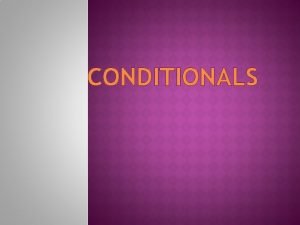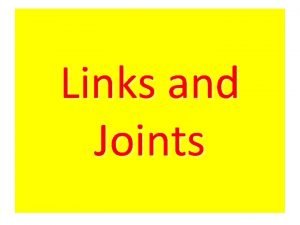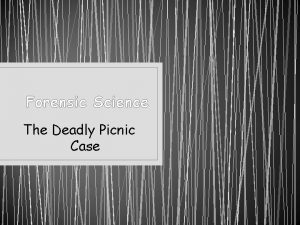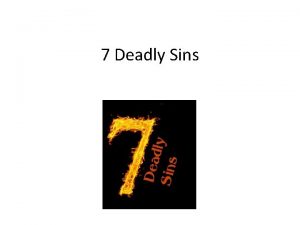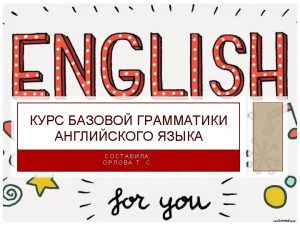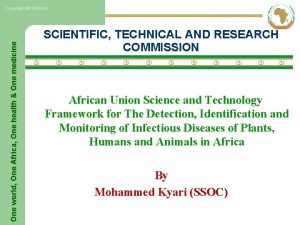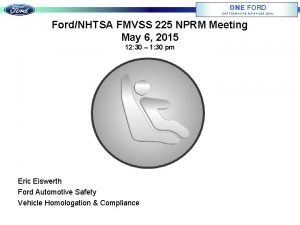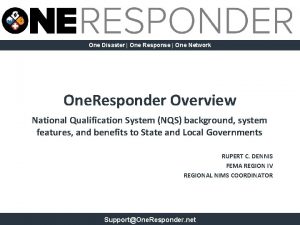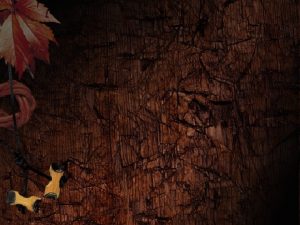Deadly Links Deadly Links Day One You will






















- Slides: 22

Deadly Links

Deadly Links: Day One You will be one of these animals in the activity: § Grasshopper – you only eat plants

§ Shrew – you eat grasshoppers

§ Hawk – you only eat shrews

Deadly Links: Day One 1. What animal were you? Grasshopper, shrew, or hawk 2. Were you eaten? Yes or no 3. What animal ate you? Shrew, hawk, or nobody Record the number of each color food pieces you have at the end of the game: Brown: _____ (If you got eaten, write 0. ) Green: _____ Yellow: _____ Total pieces of food you “ate”: _____

Deadly Links The story continues…

The Bad News… There is a pesticide in the environment. This pesticide was sprayed on the crops the grasshoppers were eating, in order to prevent a lot of damage by the grasshoppers.

Deadly Links: Day Two 1. What did the yellow food pieces represent?

Deadly Links: Day Two 1. What did the yellow food pieces represent? Yellow = pesticide

Why pesticide? Crop damage would result in: § the farmers having less of their crop to sell § people and animals not having as much food § higher costs, because of smaller quantity available

Characteristics of the pesticide: § poisonous § accumulates in food chains § stays in the environment for a long time

The Good News… Not all populations die from it. They are not all affected the same way.

2. How many pieces would your animal have had to eat before it died?

Grasshoppers Any pieces of pesticide-covered food (even just 1 single piece) = death

Shrews Half or more of your food supply contaminated (half or more of the total = death)

Hawks Don’t die from the pesticide, but one will not be able to reproduce. (The hawk with the highest number of pesticide pieces has so much accumulated in its body, that the egg shells will be too thin to hatch successfully. )

Your survival… 3. Which sentence describes your outcome? § I died because I was eaten. § I died because I ate too many yellow pieces. § I survived!

DDT § Insects were sprayed fish ate insects hawks, eagles, & pelicans ate fish § The poison became concentrated in the birds, sometimes weakening and killing them directly, and sometimes affecting their reproduction. § DDT is prohibited by law in the USA. § It has not been prohibited worldwide, and can sometimes still enter the food chain.

Fertilizers and Pesticides § Chemicals that are inorganic, synthesized compounds can have varying effects in the environment. § The pesticide might be sprayed or dusted on a crop. It might settle into the soil, or stay on the crop, until it is washed by rain or irrigation into water sources – groundwater, lakes, streams, oceans.

§ Testing the water doesn’t always show a high concentration of the chemicals, but testing the fish usually does. § Waterfowl and other species who eat the fish (including humans) can be affected. § Many of the chemicals do not pass out of their bodies, but accumulate over time.

Advantages & Disadvantages 4. What are some reasons for using pesticides, and what are some problems with using them? Advantages Disadvantages

5. What might happen if farmers didn’t use pesticides? 6. List the food chain from this activity, and tell how each link was affected by the pesticide. There were 4 links in this chain. 1 → 2 → 3 → 4
 Day 1 day 2 day 3 day 4
Day 1 day 2 day 3 day 4 Day one day one noodle ss2
Day one day one noodle ss2 Day one day one noodles ss2
Day one day one noodles ss2 Day 1 day 2 day 817
Day 1 day 2 day 817 Dying he saved me buried he carried
Dying he saved me buried he carried Perhaps one day a millionaire
Perhaps one day a millionaire One empire one god one emperor
One empire one god one emperor One one one little dogs run
One one one little dogs run One king one law one faith
One king one law one faith One empire one god one emperor
One empire one god one emperor One ford
One ford See one do one teach one
See one do one teach one One price policy
One price policy Structure of twelfth night
Structure of twelfth night Studiendekanat uni bonn
Studiendekanat uni bonn Asean tourism strategic plan
Asean tourism strategic plan Graphic organizer with the aims of la liga filipina
Graphic organizer with the aims of la liga filipina Pgcps calendar a day b day
Pgcps calendar a day b day Oceans apart day after day
Oceans apart day after day Day to day maintenance
Day to day maintenance As your room gets messier day by day, entropy is
As your room gets messier day by day, entropy is I don't know about tomorrow
I don't know about tomorrow Timeline for acts i-iii
Timeline for acts i-iii





